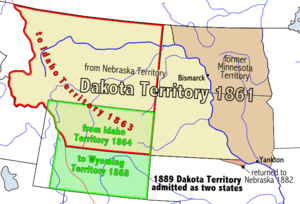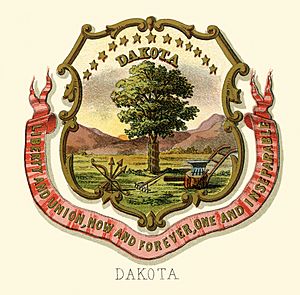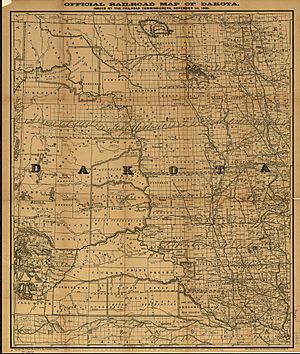Dakota Territory facts for kids
Quick facts for kids Territory of Dakota |
|||||||||||||||||
|---|---|---|---|---|---|---|---|---|---|---|---|---|---|---|---|---|---|
| Organized incorporated territory of the United States | |||||||||||||||||
| 1861–1889 | |||||||||||||||||
 |
|||||||||||||||||
| Capital | |||||||||||||||||
| • Type | Organized incorporated territory | ||||||||||||||||
| History | |||||||||||||||||
|
• Created from Nebraska and unorganized territories
|
2 March 1861 | ||||||||||||||||
|
• Idaho Territory split off
|
March 4, 1863 | ||||||||||||||||
|
• Land received from Idaho Territory
|
May 28, 1864 | ||||||||||||||||
|
• Wyoming Territory split off
|
July 25, 1868 | ||||||||||||||||
|
• North Dakota and South Dakota statehood
|
2 November 1889 | ||||||||||||||||
|
|||||||||||||||||
The Territory of Dakota was a part of the United States that was organized as a territory. It existed from March 2, 1861, until November 2, 1889. On that date, the territory was divided into two parts. These two parts then became the states of North Dakota and South Dakota.
Contents
History of Dakota Territory
| Historical population | ||
|---|---|---|
| Year | Pop. | ±% |
| 1860 | 4,837 | — |
| 1870 | 14,181 | +193.2% |
| 1880 | 158,724 | +1019.3% |
| Source: 1860–1880 (includes both North Dakota and South Dakota; | ||
The land that became Dakota Territory was mostly from the Louisiana Purchase of 1803. A smaller part came from Rupert's Land in 1818. The name "Dakota" comes from the Dakota branch of the Sioux tribes. These tribes lived in the area at that time. Before it became a territory, most of this land was part of the Minnesota Territory and Nebraska Territory.
When Minnesota became a state in 1858, some land was left over. This area was between the Missouri River and Minnesota's western border. It was not organized as a territory. Later that year, the Yankton Treaty was signed. This treaty gave a lot of land from the Sioux people to the U.S. Government.
Early settlers then tried to form their own government. They asked the U.S. Government to make it a territory, but they were not successful at first. Wilmot Wood Brookings was their temporary governor. The cities of Wilmot and Brookings are named after him. Also, Brookings County is named for him.
Three years later, Abraham Lincoln's cousin-in-law, J.B.S. Todd, helped out. He personally asked the U.S. Congress to make it a territory. Congress officially created Dakota Territory on March 2, 1861. When it was first created, Dakota Territory was very large. It included much of what is now Montana and Wyoming. It also included all of present-day North Dakota and South Dakota. A small part of present-day Nebraska was also included. President Lincoln chose William Jayne to be the first governor. Jayne was an old friend of Lincoln's from Illinois.
A small piece of land called "Lost Dakota" was a remote part of Dakota Territory. It became part of Gallatin County, Montana Territory, in 1873. Also, land north of the Keya Paha River was part of Dakota Territory. This land was moved to Nebraska in 1882.
Dakota Territory and the Civil War
The Dakota Territory was not directly involved in the American Civil War. However, it did raise some soldiers. These soldiers helped protect the settlements after the Dakota War of 1862. This war led to conflicts with the Sioux tribes in Dakota Territory. The U.S. Army sent groups into Dakota Territory in 1863, 1864, and 1865. They also built forts there. These forts helped protect the frontier settlements and river travel.
Life Before Statehood
After the Civil War, conflicts with the Sioux continued. They ended with the Treaty of Fort Laramie (1868) in 1868. By 1868, new territories were created. This made Dakota Territory smaller, to about the size of North and South Dakota today. The different counties in the territory were set up in 1872. These included Bottineau County and Cass County.
The population of the territory grew slowly at first. Then, it grew very quickly during the "Dakota Boom" from 1870 to 1880. The Sioux were seen as a threat by early settlers. This made the white population grow slowly. But over time, more settlers arrived. The Sioux were no longer seen as such a big threat.
The growth in population was largely due to the Northern Pacific Railroad. Many settlers came from other western territories. A lot of people also came from northern and western Europe. These included many Norwegians, Germans, Swedes, and Canadians.
The economy first focused on the fur trade. Furs were sent by steamboat along the rivers. Gold was found in the Black Hills in 1874. This brought more settlers and led to the last Sioux War. More people meant more demand for meat. This led to more cattle ranching on the territory's large open lands. When the railroad arrived, farming grew. Wheat became the main crop sold for money. But in the 1880s, the territory faced hard times. Wheat prices dropped, and there was a drought.
There were also disagreements between the northern and southern parts of the territory. The southern part always had more people. In 1880, the south had about 98,000 people. The north had about 37,000. The southern part also thought the north was less proper. They felt it was "too much controlled by wild folks, cattle ranchers, fur traders." They also felt there were too many conflicts with the Native Americans there. The railroad also connected the north and south to different cities. The north connected to Minneapolis–Saint Paul. The south connected to Sioux City and Omaha.
Politically, the territorial lawmakers were chosen by the federal government. They often only stayed in the region for their term. The larger population in the south started to dislike this. But people in the north often said it was cheaper to be a territory. This was because the federal government paid for many state services.
A big change happened when Governor Nehemiah G. Ordway moved the capital. In 1883, he moved it from Yankton to Bismarck. The southern part of the territory had enough people to become a state (60,000). So, in September, they held a meeting. They wrote a state constitution and let the people vote on it. The people approved it, and it was sent to Congress. A bill to make South Dakota a state passed the Senate in 1884. But it did not pass the House of Representatives. A second meeting for a South Dakota constitution happened in 1885. They wrote a new constitution, and the people voted for it by a lot.
Meetings to divide Dakota into two states also happened in the northern part. One was in Fargo in 1887, and another in Jamestown in 1888. Both asked Congress to divide the territory. They wanted both North and South Dakota to become states. Many bills were introduced in Congress about this. One bill in 1885 wanted to make South Dakota a state. It also wanted to make the northern half "Lincoln Territory." Another bill in 1886 wanted to make the whole territory one state. Still another wanted the land east of the Missouri River to be one state. The rest would be Lincoln or North Dakota Territory. Other bills in 1887 and 1888 did not pass. The territorial lawmakers in 1887 asked the people to vote on division. The vote was held in November 1887. When the results came in, Governor Louis K. Church announced the vote: 37,784 people wanted division, and 32,913 were against it.
Making new western states was a political fight between parties. Each party wanted to see how the new states would vote. In early 1888, the Democrats, led by President Grover Cleveland, suggested that four territories become states together. These were Montana, New Mexico, Dakota, and Washington. The first two were expected to vote Democratic. The last two were expected to vote Republican. This was seen as a fair deal for both sides. However, the Republicans won more seats in Congress later that year. To prevent Congress from only making Republican territories into states, the Democrats agreed to a different deal. Dakota was divided into two, and New Mexico was left out. President Cleveland signed this into law on February 22, 1889. The territories could become states nine months later. This plan meant three new Republican states and one new Democratic state.
There had been earlier tries to open up the land. But these failed because of the Treaty of Fort Laramie (1868). This treaty said that 75% of Sioux adult men on the reservation had to agree to any treaty change. A group led by Richard Henry Pratt in 1888 could not get enough signatures. Sioux leaders and even government workers opposed it. The government believed the Dawes Act (1887) meant Native Americans needed less land. This act tried to move them from hunting to farming. In reality, it caused them economic problems. Congress approved an offer of $1.25 per acre for reservation land. They also offered $25,000 to get Native Americans to sign.
A new group was chosen in April 1889. It included General George Crook, who was known for fighting Native Americans. Crook worked hard to get the Native Americans to sign. He told them that if they did not sign, the land would be taken anyway, and they would get nothing. This was a serious threat. The treaty had been ignored before when the Black Hills were taken from the Sioux. Crook did not talk to leaders like Sitting Bull and Red Cloud who were against the sale. Instead, he talked with more moderate leaders like American Horse. However, American Horse later said he was tricked into signing. Crook made many promises he could not keep. He also said he had more signatures than he did. He told people that if they did not sign, they would not get money for the land. He even let white men married to Sioux women sign. By August 6, 1889, Crook had enough signatures. Half of the reservation land was sold. The rest was divided into six smaller reservations.
Statehood
On February 22, 1889, President Cleveland signed a big bill. This bill divided the Territory of Dakota in half. North Dakota and South Dakota became states at the same time on November 2, 1889. President Harrison shuffled the papers so no one would know which one was signed first. The order was never recorded. The bill also allowed people in the new North Dakota and South Dakota territories to write state constitutions. They could also elect state governments. The four new states (North Dakota, South Dakota, Montana, and Washington) would join the U.S. in nine months. This plan left out Democratic New Mexico. It also split Republican Dakota Territory into two new Republican states. Instead of two Republican and two Democratic states, the bill created three new Republican states and one Democratic state. The Dakota Territory was divided into the states of North Dakota and South Dakota on November 2, 1889.
See also
 In Spanish: Territorio de Dakota para niños
In Spanish: Territorio de Dakota para niños



